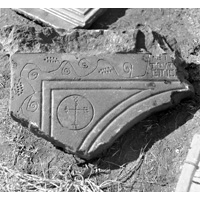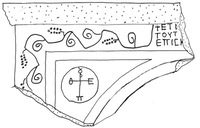 MAMA XI 151 (Pentapolis)
MAMA XI 151 (Pentapolis) 
Fragmentary building inscription
- Type of monument:
- Building inscription.
- Location:
- Menteş (Pentapolis): in a yard; said to derive from the site at Kocahüyük.
- Description:
- White marble slab forming part of a small arch, probably from a ciborium. The outer edges are moulded and decorated with an incised vine-pattern. Broken right and below, upper moulding defaced. Inscription at crown of arch; in the spandrel, incised circle with monogram.
- Dimensions:
- Ht. 0.37+; W. 0.71+; Th. 0.09+; letters 0.020-0.027.
- Record:
- Drawing; MB notebook copy; photographs (1955/79).
- Publication:
- None.
- Date:
- Fifth or sixth century AD.
† ἔτ[ους - - - ἐγένετο]
τοῦτ[ο τὸ ἔργον ἐπὶ]
ἐπισκ̣[όπου τοῦ δεῖνα]
This [work was constructed] in the year [..., when... was] bishop.





This inscription commemorates the completion of (apparently) the ciborium of the altar of a church; for the incised vine-pattern, cf. MAMA XI 185 (1955/20: Bedeş [Kayabelen]). The monogram in the spandrel may well represent the name of the bishop. The monogram includes the letters Θ, Ε, Π, Ρ and the diphthong ΟΥ. This could perhaps be resolved as Θεοπροπίου (attested as the name of a bishop at Aphrodisias: ala2004 nos. 165-6) or Θεοπρεπίου (attested as the name of a bishop at Keramos: I.Keramos 69-71).
Several other Late Antique and Middle Byzantine architectural fragments have been recorded at Menteş (MAMA XI 152 (1955/78 and 1955/78b); TIB Phrygien Abb. 131-2, 134); it is likely that all of these derive from the site at Kocahüyük, probably the site of ancient Stektorion (see the commentary to MAMA XI 135 [1955/76]), the seat of a bishopric (TIB Phrygien 389, s.v. Stektorion).